- This topic has 71 replies, 5 voices, and was last updated 3 years, 4 months ago by
Bartolomei Mirco.
-
AuthorPosts
-
16 November 2020 at 13:49 #12047
It Giulio, in practice it is, it becomes difficult if not impossible to make local or zonal assessments, the problem is in the 7 hundredths of mm of difference in the radii of curvature between center and edge, in a surface at f2.2… For nanometer sensitive tests like Ronchi and Focault they are really too many to handle.
This is a simulation of the mirror in question with a 4L / mm grating, so enough already “long”, which in theory could also read lambda / 4 ( the wider the lines of the lattice, the greater the extent of the minimum detectable defect ) .
To improve the reading of the lines it would be necessary to further widen the lines of the reticle and reach up to a single line per millimeter, but in doing so the sensitivity of the test to error would be higher than the lambda.
In the image, the test done with a 4-2-1 linee/mm
 21 November 2020 at 3:12 #12048
21 November 2020 at 3:12 #12048The study continues in small steps…
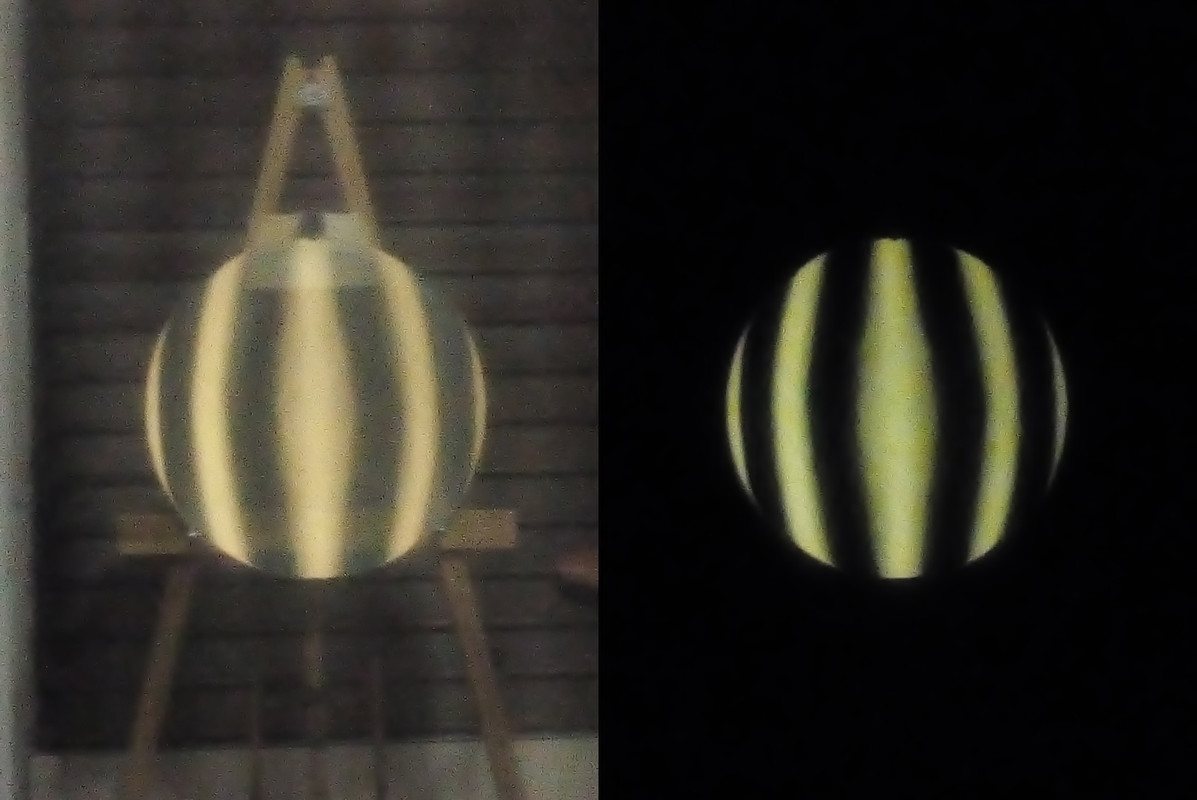
In the image on the left, I forgot to turn off the light before taking the picture. On the right instead, I remembered it



For further information I am using only tangential rides along the circumferences of the central areas, interspersed with a few laps of W races ( even these power plants without ever reaching the edge completely ) to make the worked areas uniform.
22 November 2020 at 18:45 #12049I understand the difficulty.
I don't know if you already know what follows, in case parabolization could help you…since always you “what you touch better”, always managing to turn the result in your favor
 .
.A while ago wandering around Mel Bartel's papers I had seen “on the fly”, the existence of a method that facilitated the evaluation of the curvature of the Ronchi test.
The method consists in superimposing an image taken on the rhonchigram of the mirror under examination, to another image “negative” of the equivalent ronchigram simulated by the Ronchi Matching program, for a common offset distance” (obviously understood as the same positioning distance of the real and simulated gratings, from the center of curvature).
http://www.bbastrodesigns.com/ronchi.htmlthe following image shows what I am saying:
http://bbastrodesigns.com/JoyOfMirrorMaking/25%20inch%20quarter%20wavefront%20undercorrected%20at%20center.jpg.
And it is taken from the article “making a mirror of 25″ F2,6” by Mel.
http://bbastrodesigns.com/JoyOfMirrorMaking/25%20inch%20f2.6%20mirror.htmlThe image shows the overlap of the two images, of which the one with the black bands should be relative to the ronchigram actually detected on the mirror under examination, while the one with a pink background is generated by the simulator “in negative” ie with white bands on a pink background, works , due to the error present, they do not completely overlap the black ones, but the white residue remains visible, the part of the error present.
In fact the black bars adhere to the internal curvature of the white ones generated by the computer.I understand that it would also be possible to print two simulations with a certain value of lambda / x apart from each other, to see at what distance from acceptability the mirror being processed currently resides.
However, another thing remains the difficulties related to the corrections to be applied to ensure that the black curves fill the spaces of the white ones….
 23 November 2020 at 11:58 #12053
23 November 2020 at 11:58 #12053I realize that I am just inadequate…..

I couldn't figure out how the hell to go about it “upload to Browser” an image of me Ronchigram, as Mel Bartel suggests in the description of his Matching Ronchi test, as if it were the simplest thing in this world .23 November 2020 at 15:43 #12054
.23 November 2020 at 15:43 #12054I understand the difficulty.
I don't know if you already know what follows, in case parabolization could help you ... since you have always "the best you touch", always managing to turn the result in your favor
 .
.Giulio, I thank you for your trust, but I don't think so ( maybe!
 )…
)… And, we talked about it some time ago with you and Mirco, both of Mel's work and of the different methods of using the Ronchi with supporting images… I remember that Mirco had also proposed a print of the Ronchigram to be applied on the mirror during testing.
Anyhow, with all respect and admiration for Bartel, I always stay a while’ perplexed when it is proposed to finalize an optic with the Ronchi.
for charity, the Ronchi is a formidable and very helpful tool, but I think it should be used for what it is in its nature and that is, provide an overview of the optics, to highlight zonal irregularities, folded edges, astigmatism and roughness, but I don't think we can expect to measure something with an instrument which by definition does not give measurements or numbers as a result.
Moreover, if for mirrors around F6 the detection of the minimum error is visually quite good ( around lambda / 10 ) as the focal ratio decreases, the size and distance of the reticle lines increase, therefore consequently the minimum detectable error increases.
In a reticle F3 2 linee/mm ( admitted having a view from “falco” ) is around lambda / 2, in an F2 it is higher than the lambda.Personally, I use the Ronchi only in the construction of the sphere and in the phases of approach to the parable, ( as well as for the aspects mentioned above ), but I would never dream of making a parable with Ronchi alone, I would not be able and I do not understand how it is possible to evaluate a correction expressed in wave fractions with a grating that provides an approximation greater than the required tolerance , with the addition of the “subjectivity” of the operator who measures nothing but visually evaluates a deformation, even with all the help of overlapping masks or images,
The usefulness of the Ronchi lies in the simplicity and speed of the test, in practice it is immediate and provides an excellent overall evaluation and is fine until the time when the measures are not necessary.
I will try to reach the parable for this F2.2 in progress with Foucault , starting to use it as soon as I reach a conic constant ( estimated with the Ronchi, even crudely ) of at least K =-0,7 .
Subsequently, in the vicinity of K = -1 ( with all the limitations of Foucault for fast mirrors ), I will use the long and laborious but very precise caustic test to arrive at the final hyperbola, which differs little from the paraboloid ( K=-1.12 )
24 November 2020 at 23:36 #12055well Massimo.
my surviving neuron did not allow me to remember that I had already mentioned the use of Mel Bartel's Ronchi matching.
did not allow me to remember that I had already mentioned the use of Mel Bartel's Ronchi matching.I also believe that to achieve such a large and accentuated surface curvature while respecting tolerances, the best way to test is the classic one, than with Ronchi purely visual, flanked to Foucault leads to the sphere and beyond but only up to the proximity of the lambda / 4 parabola, to continue with the caustic test to destination, putting in place the external areas of the mirror, notoriously more extensive and steep and impossible to bring to the correct destination even by the Foucault test.
The use of Ronchi throughout the processing of such open and short focal lengths, it is a shortcut to demonstrate satisfactory personal impressions of sufficiency with only one, that it would be easy to achieve what is actually not easy, because the resulting work is only indefinitely approximated.
Unbelievable because the Ronchi test notoriously does not provide any descriptive number of the quality of the curvature obtained, indicating the deviations from the proper numbers describing the curvature taken as a constructive reference.24 November 2020 at 23:50 #12056The excavation continues with a patina of pitch and cerium oxide, the races a “W” generate a good parabolic shape, but they are not very suitable for reaching depth “quickly” while tangential runs along a circumference dig quickly, but maintaining the shape is difficult and must be interspersed with strokes a “W” to connect the zones.
So, I thought and found an alternative that is able to generate depth quickly and at the same time generate a parabolic shape.
I called them “run to Y”
The following diagram shows the setup and execution of the technique for a sub-diameter al 33% ( what I am using )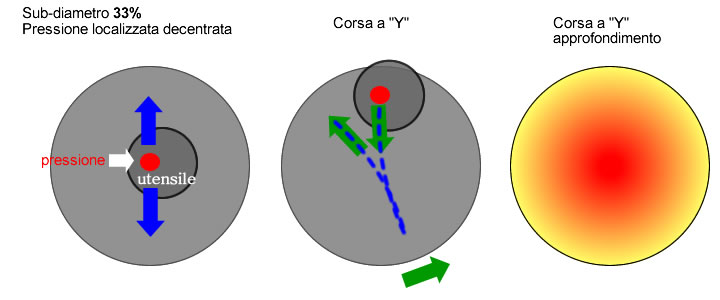
All you have to do is imagine you are performing straight runs center to center while the mirror moves on a rotating plane.
If you don't have a rotating table available, straight runs are performed ( not with respect to the mirror but with respect to oneself ) while moving fairly quickly around the table.
With one important difference: the pressure should not be applied to the center of the tool but should be decentralized by at least 1/3 the diameter.This aspect is important, why the COC runs with sub-diameter, generate a spherical shape in the mirror area that has the same extension as the tool, and even if they dig more in the center of the mirror, the resulting shape will be quite far from the parabola.
the off-center strokes instead allow to create a machining asymmetry in which the center , at every run, it is always affected by excavation while the remaining areas undergo a minor excavation action depending on the distance from the center.
– the offset must be small but not zero or, even worse, “negative” ( otherwise they create “steps” in the middle area.
– movement around the table must be fast enough ( but not too much ), the “Y,” that is, it doesn't have to be too much “hold” nor too much “long”.Below, the images after a few sessions with this technique without performing other connecting runs.
With a few sessions ( morning + part of the afternoon ) the center was excavated 10% the required depth. In fact now the conic has reached a constant of K =-0.2, while before this process it had arrived ( with difficulty and difficulty in maintaining shape ) a K=-0.1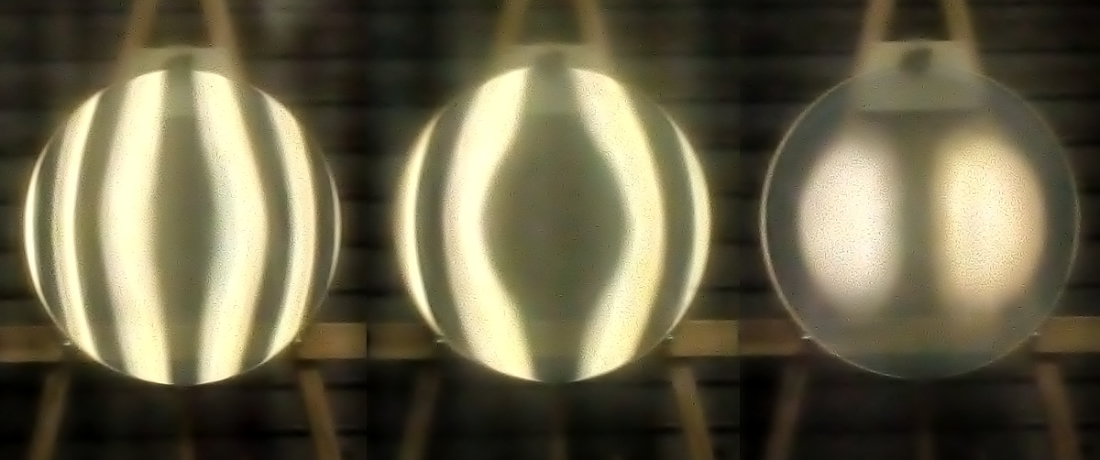
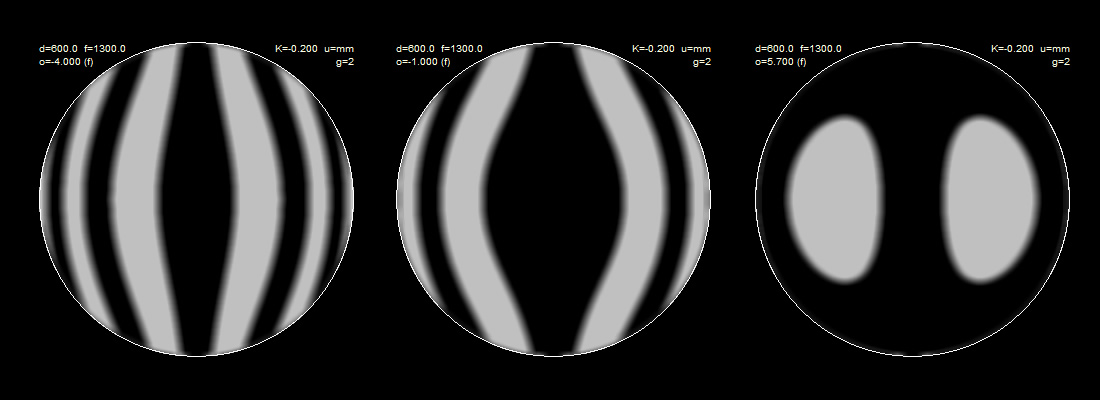
– the “step” seen in the middle area is now almost absorbed, but in the beginning it was generated precisely because I had performed the Y runs without touching the mirror edge and therefore the median area remained a little’ higher than it should, as can be seen by comparing the images with the simulation of Ronchi for K =-0.2.
26 November 2020 at 15:01 #12057And. Now the central area seems to me only slightly deeper, with the narrowing slightly more marked in the connection with the periphery.
26 November 2020 at 19:35 #12058It Giulio, it is as you say, the median area has remained high compared to the center which has been mostly excavated.
As I said, it was my mistake of “experimentation” , Y-strokes should be extended to the edge with a slight offset to hollow out all areas with the correct proportion.
, Y-strokes should be extended to the edge with a slight offset to hollow out all areas with the correct proportion.
With two more sessions performed correctly, the figure is becoming better connected and at the same time the conic constant is further lowered ( that is, the center is now even deeper ). At the moment, even without the comparison with the simulations I think we are almost at K =-0,3 ( or so… ) 29 November 2020 at 18:44 #12059
29 November 2020 at 18:44 #12059And nothing, we are still at a conic constant of K =-0.25, I thought better…

There is still a long way to go before we start taking some measurements !

 29 November 2020 at 20:22 #12060
29 November 2020 at 20:22 #12060It already looks beautiful though.
So if the parabola has K = 1, with -0,25 you're already in a lot of hyperbole .. or am I wrong? (…Not using them for a long time, I get confused with the meaning of positive and negative K's!)29 November 2020 at 21:15 #12061Ahah Giulio, sometimes I don't know if you're kidding me or if you just want to see if I've "studied"
 , considering that ( now years ago ) it was you who explained the correct interpretation and calculation of the conic constants ( in particular on Focault ).
, considering that ( now years ago ) it was you who explained the correct interpretation and calculation of the conic constants ( in particular on Focault ). 
Anyway, in the case of the second hypothesis, it can be said that at the moment they are in an ellipse ( with K negative ).
As you know better than me, the value of K defines the type of conic we are examining:
for K = 0 we have a sphere, for values between 0 e -1 we have an ellipse, for K = -1 a parabola, for K less than -1 we have a hyperbole.
So we can say that at the moment, with K =-0.25 ( I started from the sphere with K = 0 ) , I walked a quarter of the way that normally one has to do to get to the parable. Once you get to the parable ( K=-1 ), I will have to dig for a while until I reach the design value K = -1.12, therefore a hyperbola that deviates slightly from the parabola of a mirror of the same focal length.
The biggest difficulty in all of this is not so much in the large amount of glass that needs to be scratched, as much as trying to do it without straying too far from the shape of the corresponding theoretical conic, so as to arrive at the end of the excavation with a figure that ( maybe ), it may not need a titanic work of corrections to bring all areas into tolerance.2 December 2020 at 18:37 #12062Thanks Massimo for reminding me.
The fact is that I forget the notions (…and where things are from) which I haven't used in a long time.
I think it is normally a geriatric fact for those over 70…Unfortunately!4 December 2020 at 1:48 #12063Giulio, the only ones who do not risk forgetting the notions are those who do not have them, in fact I have very little to forget and I live in peace
 … where I put things, however, I often forget it too, even if I used them five minutes before !
… where I put things, however, I often forget it too, even if I used them five minutes before ! 
Returning to the mirror, the work goes on and I have increased by another tenth the value of the conic constant which is now K =-0.35, in practice I walked the 35% of the way to the parable.
Therefore, on the image I have also inserted a progress bar which, as well as reminding me where I am, makes more “scenographic” the photo of Ronchi

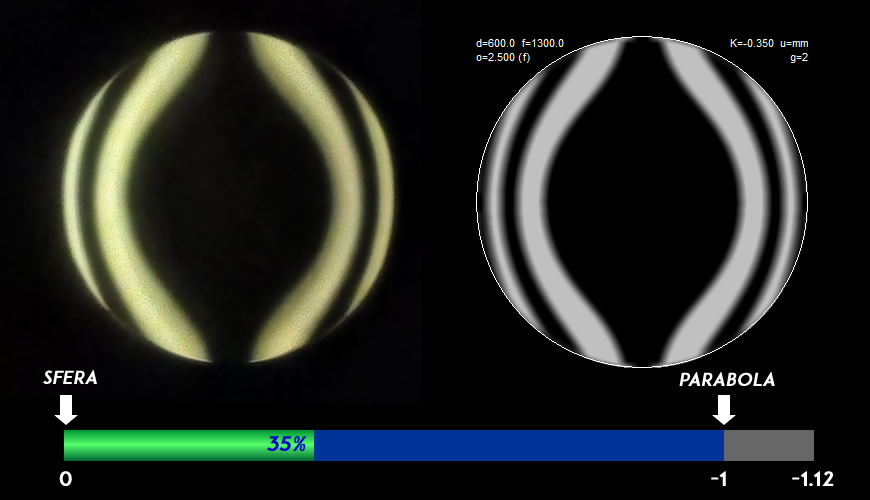
The figure is not bad, even if the more peripheral sector remains slightly high ( of how much, with Ronchi you can't know, we will have to wait for the first tests with Foucault ) .
therefore, in the next sessions I will try to reach the external areas more effectively to try a better connection with the median area.4 December 2020 at 9:39 #12064Nice comparison system.
The right hemisphere seems slightly more worked. -
AuthorPosts
- You must be logged in to reply to this topic.